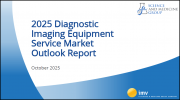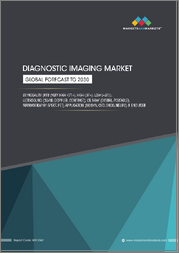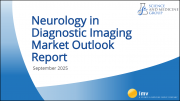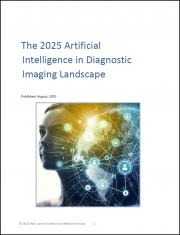
|
시장보고서
상품코드
1848039
중국의 영상 진단 : 시장 점유율 분석, 산업 동향, 통계, 성장 예측(2025-2030년)China Diagnostic Imaging - Market Share Analysis, Industry Trends & Statistics, Growth Forecasts (2025 - 2030) |
||||||
중국의 영상 진단 시장 규모는 2025년에 41억 7,000만 달러로 추계되며, 예측 기간(2025-2030년)의 CAGR은 7.39%로, 2030년에는 59억 5,000만 달러에 달할 것으로 예상됩니다.

국내제조에 대한 정부의 강력한 지원, 급속한 인공지능(AI) 통합, 정책 주도의 가격 인하로 경쟁의 역학이 재정의되어 도시와 농촌의 환경 전체에 걸쳐 고도의 모달리티에 대한 접근이 확대되고 있습니다. 유나이티드 이미징과 Neusoft Medical과 같은 국내 혁신자들은 비용 경쟁력 있는 하드웨어와 AI 지원 워크플로 도구를 결합하여 다국적 공급업체의 역사적 이점을 계속 침식하고 있습니다. 수량 기준 조달(VBP)은 특히 2024년까지 보급률이 낮게 유지된 하위층현에서 가격 압축과 수요 환기를 동시에 실시했습니다. AI 도입은 워크플로우의 효율화를 가속시킵니다. 인간과 AI의 협동으로 3차 병원에서는 진단 감도를 12% 향상시키면서 평균 화상 읽기 시간을 27.2% 단축했습니다. 이러한 힘이 결합되어 종양학, 심장병학, 만성질환 모니터링의 각 분야에서 지속적인 수요가 뒷받침되고 있습니다.
중국의 영상 진단 시장 동향과 인사이트
만성 질환의 유병률 상승
중국에서는 2050년까지 비전염성 질환이 전 사망 원인의 93%를 차지할 것으로 예상되고 있으며, 의료계획자는 조기 발견과 장기적인 모니터링을 위한 영상 진단 능력의 확충을 강요받고 있습니다. 노인들은 이미 66.3%의 만성 질환 유병률을 보였으며 CT와 MRI에 의한 추적검사에 대한 수요가 증가하고 있습니다. 저선량 CT(LDCT) 프로그램은 현재 사천성에서 1시간 이내에 이동할 수 있는 고위험 주민의 96.95%를 다루고 있지만, 농촌의 진찰률은 34.72%로 여전히 낮습니다. 당뇨병의 POC(Point-of-Care) 검사는 현립 병원에서 QALY 당 USD 185의 비용 효과를 나타내며 휴대용 초음파 검사와 HbA1c 키트의 대량 구매를 촉구하고 있습니다. 이러한 패턴은 순수한 치료 인프라에서 확장 가능한 진단 플릿으로 투자를 옮깁니다.
노년 인구 증가
평균 수명은 2050년까지 82.1세에 달할 것으로 예상되며, 다질환 합병률은 75-84세의 코호트에서 33.7%로 피크에 달하며 암, 심혈관, 신경퇴행 감시를 위한 영상 진단의 필요성이 높아집니다. 2018년 이후 노인 간호 수요와 자원 공급 조정이 개선되었지만, 특히 내륙 지역에서는 노인 인구 증가율을 아직 웃돌고 있습니다. '건강한 중국 2030'계획에서는 예방적 영상 진단이 노화 관련 질환을 관리하기 위한 초석으로 자리매김하고 있으며, 지역 병원에서의 심 초음파 검사와 듀얼 에너지 CT에 대한 조성이 촉진되고 있습니다. 이동식 CT버스가 원격지 마을에 파견되게 되어 이동에 따른 치료 지연이 감소하고 있습니다. 의사 밀도는 2024년에는 인구 10,000명당 30.4명으로 상승했지만, 방사선과 의사의 부족은 여전히 계속되고 있으며, AI 트리어지 도구의 필요성이 부각되고 있습니다.
고액의 도입 비용과 평생 소유 비용
VBP 할인 이후에도 하이엔드 MRI는 200만 달러를 넘어 Tier3 시설 예산을 압박합니다. 고급 CT 구성 요소의 관세는 1대당 20만 달러에 이르고, 일부 중국 기업들은 공급망을 ASEAN 시장으로 옮겨야 합니다. 지멘스 헬시니어스와 GE 헬스케어는 2024년 주요 병원의 발주 연기로 1자리대 중반의 감수를 보고하여 조달의 순환성이 부각되었습니다. 주별 효율성 조사는 서부 지역의 평균 효율성 점수가 0.979인 반면 해안에서는 거의 균일한 등 자본 배분의 격차가 근본적인 것으로 나타났습니다.
부문 분석
2024년 중국의 영상 진단 시장에서 X선은 27.53%로 최대 점유율을 유지했으며, 이는 합리적인 가격과 1차 케어 클리닉에서의 정착을 반영하고 있습니다. 반복 재구성 및 광자 계수 업그레이드를 뒷받침하는 컴퓨터 단층 촬영은 군립 병원에서 종양학 및 심혈관계에 대한 수요를 캡처하고 부문 톱 CAGR 8.87%를 나타낼 것으로 예측됩니다. 정부의 보조금 제도에 의해 구식의 아날로그 장치가 단계적으로 폐지되는 가운데, 디지털 X선 촬영 장치에의 이행이 계속되고 있습니다. 한편, PCT의 시험시설에서는 방사선량의 40% 절감과 골미세구조의 가시화의 대폭적인 개선이 보고되고 있으며, CT는 대량의 정형외과 검사에 있어서의 유력한 과제가 되고 있습니다.
휴대용 초음파 장치와 휴대용 X 선 장치는 아웃 리치 프로그램의 고정 모드를 보완하고 듀얼 트랙 전개 모델을 강조합니다. 핵 의학은 틈새 시장이지만 전략적 역할을 담당합니다. 1,200개 병원이 연간 390만 명의 환자에 대해 게이트 SPECT 및 PET 검사를 실시하고 있으며, 국내 방사성 동위 원소 공급이 점차 개선되고 있습니다. MRI 벤더는 현장에서의 설치를 용이하게 하기 위해 헬륨이 없는 시스템을 추구하고, AI 대응 투시 검사는 인터벤셔널 절차 중 선량률 변조를 자동화합니다. 이러한 업그레이드는 중국의 영상 진단 시장 전체의 다양한 임상 환경에 대응하는 광범위한 모달리티 믹스를 견고하게 만듭니다.
높은 슬라이스 CT나 3T MRI가 고가격으로 거래되는 3차 병원에서의 조달이 정착하고 있는 것을 반영해 고정식 병실의 매출은 여전히 81.74%를 차지하고 있습니다. 그러나 모바일 및 핸드헬드 시스템은 농촌의 건강 의무화와 VBP의 합리적인 가격으로 뒷받침되며 CAGR 8.92%를 나타낼 것으로 예측되고 있습니다. 저선량 X선, 심전도, 초음파를 통합한 건강 올인원 키오스크는 해남의 파일럿 사이트에서 효과가 입증되어 2자리수의 환자수 증가를 견인하고 있습니다.
국내 혁신 기업들은 현재 응급 의료 및 응급 차량을 위한 배터리 구동 핸드헬드 CT를 제공하고 케어의 경계를 확대하고 있습니다. 5G와 엣지 컴퓨팅 플랫폼으로 구축된 원격 영상 진단 프레임워크는 마을 클리닉에서 촬영한 영상이 60초 이내에 시의 방사선과 의사에게 도달할 것을 보장하고 노동력 부족을 보완합니다. 그 결과, 모바일 시스템은 하이엔드 고정 설비와 카니버리화 없이 증가하는 볼륨을 획득하는 태세를 갖추어 중국의 영상 진단 시장 규모에 퍼져 나가고 있습니다.
기타 혜택 :
- 엑셀 형식 시장 예측(ME) 시트
- 3개월의 애널리스트 서포트
목차
제1장 도입
- 조사 전제조건과 시장 정의
- 연구 범위
제2장 조사 방법
제3장 주요 요약
제4장 시장 상황
- 시장 개요
- 시장 성장 촉진요인
- 만성 질환 증가
- 노년 인구 증가
- 첨단 화상 기술의 채용 증가
- 정부 장비 업그레이드 보조금과 DRG 롤아웃
- 지방에의 보급을 가속시키는 볼륨 베이스 조달(Vobp)
- AI에 의한 생산성 향상이 방사선과의 부족을 완화
- 시장 성장 억제요인
- 높은 취득 비용과 평생 소유 비용
- 방사선/조영제의 안전성에 대한 우려
- OEM 마진을 압박하는 Vobp의 가격 압축
- 의료기기 입수의 주간 격차
- 공급망 분석
- 규제 상황
- 기술적 전망
- Porter's Five Forces 분석
- 신규 참가업체의 위협
- 구매자의 협상력
- 공급기업의 협상력
- 대체품의 위협
- 경쟁 기업 간 경쟁 관계의 강도
제5장 시장 규모·성장 예측
- 모달리티별
- MRI
- 저자기장(1.5 T미만)
- 고자기장(1.5-3 T)
- 초고자장(3 T초)
- CT
- 저단면(<32)
- 중간단면(32-128)
- 고층단면(>128 &광자 계수 방식)
- 초음파
- 2차원
- 3차원/4차원
- 휴대용 및 POCUS
- X선
- 아날로그
- 디지털(DR/CR)
- 핵의학 이미징
- PET
- SPECT
- 형광 투시
- 유방촬영술
- MRI
- 휴대성별
- 고정형 시스템
- 이동형 및 휴대형 시스템
- 용도별
- 심장학
- 종양학
- 신경학
- 정형외과
- 위장관학
- 산부인과
- 응급의학
- 기타 용도
- 최종 사용자별
- 병원
- 진단 영상 센터
- 기타 최종 사용자
제6장 경쟁 구도
- 시장 집중도
- 시장 점유율 분석
- 기업 프로파일
- United Imaging Healthcare
- GE HealthCare
- Siemens Healthineers AG
- Koninklijke Philips NV
- Canon Medical Systems Corporation
- Shenzhen Mindray Bio-Medical Electronics Co., Ltd
- Wandong Medical
- SonoScape
- Neusoft Medical
- Shenzhen Anke High-tech
- Carestream Health
- Hologic
- Shimadzu
- Samsung Medison
- Esaote
- AllTech Medical Systems
- MinFound Medical
- PI Medical Diagnostic Equipment
- Shenzhen Mindeye 3D(Hand-held CT)
- Tencent YouTu(AI SaaS)
제7장 시장 기회와 전망
KTHThe China Diagnostic Imaging Market size is estimated at USD 4.17 billion in 2025, and is expected to reach USD 5.95 billion by 2030, at a CAGR of 7.39% during the forecast period (2025-2030).
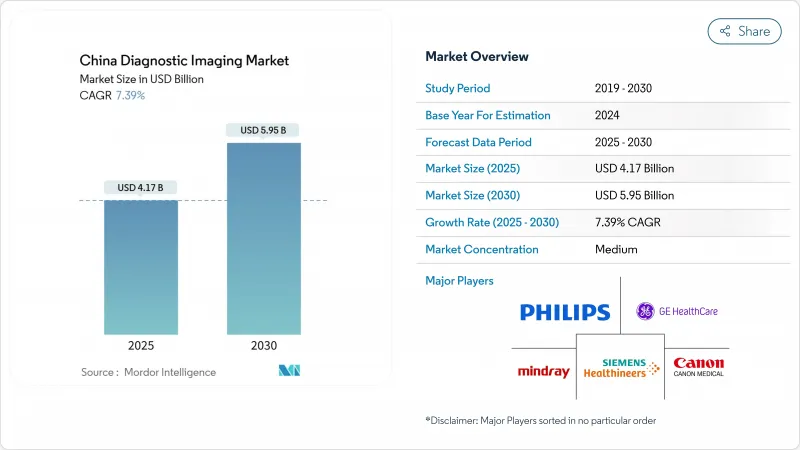
Robust government support for domestic manufacturing, rapid artificial-intelligence (AI) integration, and policy-driven price reductions are redefining competitive dynamics and expanding access to advanced modalities across urban and rural settings. Domestic innovators such as United Imaging and Neusoft Medical continue to erode the historic dominance of multinational vendors by pairing cost-competitive hardware with AI-enabled workflow tools. Volume-based procurement (VBP) is simultaneously compressing prices and stimulating unit demand, especially in lower-tier counties where penetration remained low until 2024. AI adoption is accelerating workflow efficiency; human-AI collaboration has cut average image-reading time by 27.2% while lifting diagnostic sensitivity by 12% in tertiary hospitals. Together, these forces underpin sustained demand across oncology, cardiology and chronic-disease monitoring segments.
China Diagnostic Imaging Market Trends and Insights
Rise in Prevalence of Chronic Diseases
Non-communicable diseases are expected to cause 93% of all deaths in China by 2050, pushing health planners to expand imaging capacity for early detection and longitudinal monitoring. Older adults already show 66.3% chronic-disease prevalence, reinforcing demand for CT and MRI follow-up exams. Screening policies are broadening; low-dose CT (LDCT) programs now cover 96.95% of high-risk residents within one-hour travel in Sichuan, yet rural adherence still lags at 34.72%. Diabetes point-of-care testing demonstrates cost-effectiveness at USD 185 per QALY in county hospitals, encouraging bundled procurement of portable ultrasound and HbA1c kits. These patterns shift investment away from purely therapeutic infrastructure toward scalable diagnostic fleets.
Growing Geriatric Population
Life expectancy is forecast to hit 82.1 years by 2050, with multimorbidity peaking at 33.7% in the 75-84 cohort, amplifying imaging requirements for cancer, cardiovascular and neurodegenerative surveillance. Coordination between elder-care demand and resource supply improved after 2018 but still trails the growth rate of the senior population, especially in interior provinces. The Healthy China 2030 plan identifies preventive imaging as a cornerstone for managing age-related disease, prompting subsidies for echocardiography and dual-energy CT in community hospitals. Mobile CT buses are increasingly dispatched to remote villages, reducing travel-related care delays. Physician density rose to 30.4 per 10,000 residents in 2024, yet radiologist shortfalls endure, underscoring the need for AI triage tools.
High Acquisition & Lifetime Ownership Costs
Even after VBP discounts, high-end MRI can exceed USD 2 million, straining budgets for tier-3 facilities. Tariffs on premium CT components add up to USD 200,000 per unit, prompting some Chinese firms to relocate supply chains to ASEAN markets. Order deferrals by major hospitals in 2024 led Siemens Healthineers and GE HealthCare to report mid-single-digit revenue declines, underscoring procurement cyclicality. Provincial efficiency studies reveal persistent capital-allocation disparities, with western regions averaging a 0.979 efficiency score versus near-unity in coastal areas.
Other drivers and restraints analyzed in the detailed report include:
- Increased Adoption of Advanced Imaging Technologies
- Government Equipment-Upgrade Subsidies & DRG Roll-Out
- Radiation / Contrast-Agent Safety Concerns
For complete list of drivers and restraints, kindly check the Table Of Contents.
Segment Analysis
X-ray maintained the largest share of the China diagnostic imaging market at 27.53% in 2024, reflecting its affordability and entrenched presence in primary-care clinics. Computed tomography, fueled by iterative reconstruction and photon-counting upgrades, is forecast to post the segment-leading 8.87% CAGR, capturing oncology and cardiovascular demand in county hospitals. Digital radiography migration continues as older analog units phase out under government subsidy schemes. Meanwhile, PCCT pilot sites report 40% radiation-dose savings and sharply improved bone-microstructure visualization, positioning CT as a credible challenger for high-volume orthopedic exams.
Portable ultrasound and handheld X-ray units complement fixed modalities in outreach programs, underscoring a dual-track deployment model. Nuclear medicine retains a niche but strategic role; 1,200 hospitals run gated SPECT or PET studies for 3.9 million patients annually, with domestic radio-isotope supply gradually improving. MRI vendors pursue helium-free systems to ease rural installs, while AI-enabled fluoroscopy automates dose-rate modulation during interventional procedures. Together, these upgrades solidify a broad modality mix to serve heterogeneous clinical settings across the China diagnostic imaging market.
Fixed rooms still account for 81.74% revenue, reflecting entrenched procurement in tertiary hospitals where high-slice CT and 3 T MRI command premium prices. Yet mobile and handheld systems are forecast to expand at an 8.92% CAGR, propelled by rural-health mandates and VBP affordability. Health All-in-One kiosks integrating low-dose X-ray, ECG, and ultrasound have proven effective in Hainan pilot sites, driving double-digit patient-volume gains.
Domestic innovators now offer battery-powered handheld CT for emergency medicine and ambulance use, widening point-of-care boundaries. Tele-radiology frameworks built on 5G and edge-computing platforms ensure that images captured in township clinics reach city radiologists in under 60 seconds, offsetting workforce shortages. As a result, mobile systems are poised to capture incremental volumes without cannibalizing high-end fixed installations, adding breadth to the China diagnostic imaging market size.
The China Diagnostic Imaging Market Report is Segmented by Modality (MRI, CT, Ultrasound, X-Ray, Nuclear Imaging, Fluoroscopy, Mammography), Portability (Fixed Systems, Mobile and Hand-Held Systems), Application (Cardiology, Oncology, Neurology, Orthopedics, Gastroenterology, and More), End User (Hospitals, Diagnostic Imaging Centres, Other End-Users), and Geography. The Market Forecasts are Provided in Terms of Value (USD).
List of Companies Covered in this Report:
- United Imaging Healthcare
- GE Healthcare
- Siemens Healthineers
- Koninklijke Philips
- Canon
- Mindray
- Wandong Medical
- SonoScape
- Neusoft
- Shenzhen Anke High-tech
- Carestream Health
- Hologic
- Shimadzu
- Samsung Group
- Esaote
- AllTech Medical Systems
- MinFound Medical
- PI Medical Diagnostic Equipment
- Shenzhen Mindeye 3D (Hand-held CT)
- Tencent YouTu (AI SaaS)
Additional Benefits:
- The market estimate (ME) sheet in Excel format
- 3 months of analyst support
TABLE OF CONTENTS
1 Introduction
- 1.1 Study Assumptions & Market Definition
- 1.2 Scope of the Study
2 Research Methodology
3 Executive Summary
4 Market Landscape
- 4.1 Market Overview
- 4.2 Market Drivers
- 4.2.1 Rise in Prevalence of Chronic Diseases
- 4.2.2 Growing Geriatric Population
- 4.2.3 Increased Adoption of Advanced Imaging Technologies
- 4.2.4 Government Equipment-Upgrade Subsidies & DRG Roll-Out
- 4.2.5 Volume-Based Procurement (Vobp) Accelerating Rural Penetration
- 4.2.6 AI-Driven Productivity Gains Easing Radiologist Shortage
- 4.3 Market Restraints
- 4.3.1 High Acquisition & Lifetime Ownership Costs
- 4.3.2 Radiation / Contrast-Agent Safety Concerns
- 4.3.3 Vobp Price Compression Squeezing OEM Margins
- 4.3.4 Inter-Provincial Inequality of Device Availability
- 4.4 Supply-Chain Analysis
- 4.5 Regulatory Landscape
- 4.6 Technological Outlook
- 4.7 Porter's Five Forces Analysis
- 4.7.1 Threat of New Entrants
- 4.7.2 Bargaining Power of Buyers
- 4.7.3 Bargaining Power of Suppliers
- 4.7.4 Threat of Substitutes
- 4.7.5 Intensity of Competitive Rivalry
5 Market Size & Growth Forecasts (Value)
- 5.1 By Modality
- 5.1.1 MRI
- 5.1.1.1 Low / Mid-field (<1.5 T)
- 5.1.1.2 High-field (1.5-3 T)
- 5.1.1.3 Ultra-high-field (>3 T)
- 5.1.2 CT
- 5.1.2.1 Low-slice (<32)
- 5.1.2.2 Mid-slice (32-128)
- 5.1.2.3 High-slice (>128 & photon-counting)
- 5.1.3 Ultrasound
- 5.1.3.1 2-D
- 5.1.3.2 3-D / 4-D
- 5.1.3.3 Hand-held & POCUS
- 5.1.4 X-ray
- 5.1.4.1 Analog
- 5.1.4.2 Digital (DR / CR)
- 5.1.5 Nuclear Imaging
- 5.1.5.1 PET
- 5.1.5.2 SPECT
- 5.1.6 Fluoroscopy
- 5.1.7 Mammography
- 5.1.1 MRI
- 5.2 By Portability
- 5.2.1 Fixed Systems
- 5.2.2 Mobile and Hand-held Systems
- 5.3 By Application
- 5.3.1 Cardiology
- 5.3.2 Oncology
- 5.3.3 Neurology
- 5.3.4 Orthopedics
- 5.3.5 Gastroenterology
- 5.3.6 Gynecology & Obstetrics
- 5.3.7 Emergency Medicine
- 5.3.8 Other Applications
- 5.4 By End User
- 5.4.1 Hospitals
- 5.4.2 Diagnostic Imaging Centres
- 5.4.3 Other End-users
6 Competitive Landscape
- 6.1 Market Concentration
- 6.2 Market Share Analysis
- 6.3 Company Profiles (includes Global level Overview, Market level overview, Core Segments, Financials as available, Strategic Information, Market Rank/Share for key companies, Products & Services, and Recent Developments)
- 6.3.1 United Imaging Healthcare
- 6.3.2 GE HealthCare
- 6.3.3 Siemens Healthineers AG
- 6.3.4 Koninklijke Philips N.V.
- 6.3.5 Canon Medical Systems Corporation
- 6.3.6 Shenzhen Mindray Bio-Medical Electronics Co., Ltd
- 6.3.7 Wandong Medical
- 6.3.8 SonoScape
- 6.3.9 Neusoft Medical
- 6.3.10 Shenzhen Anke High-tech
- 6.3.11 Carestream Health
- 6.3.12 Hologic
- 6.3.13 Shimadzu
- 6.3.14 Samsung Medison
- 6.3.15 Esaote
- 6.3.16 AllTech Medical Systems
- 6.3.17 MinFound Medical
- 6.3.18 PI Medical Diagnostic Equipment
- 6.3.19 Shenzhen Mindeye 3D (Hand-held CT)
- 6.3.20 Tencent YouTu (AI SaaS)
7 Market Opportunities & Future Outlook
- 7.1 White-Space & Unmet-Need Assessment




